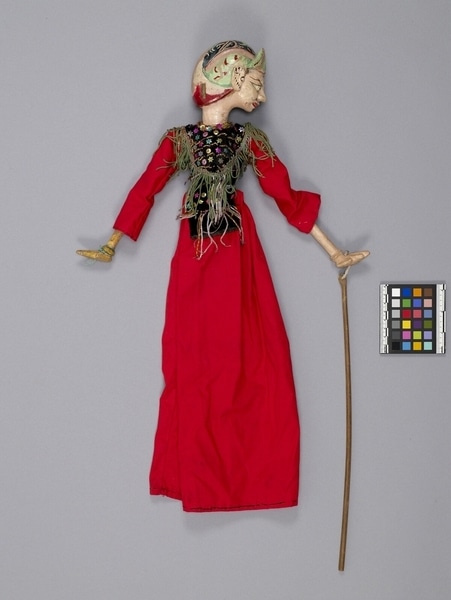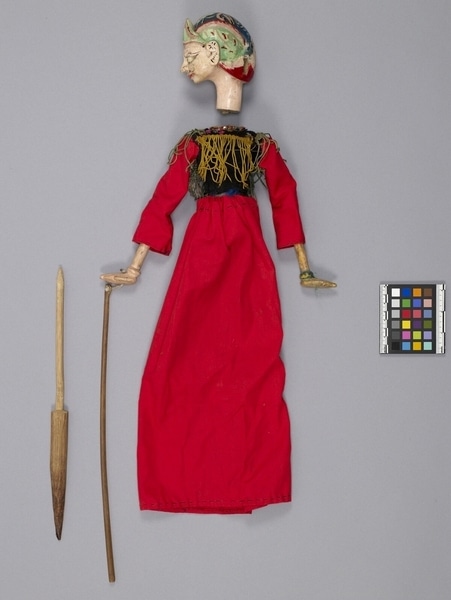Rod Puppet Item Number: Ib328 a-c from the MOA: University of British Columbia


Description
Three-dimensional male humanoid puppet: large head (part b) fits into body with skirt (part a), and a control rod (part c) with a long shaft that passes through the body and fits into the neck of the figure's head. The body has jointed arms, each with a long controlling rod attached. Face pale pink, mouth closed, thin red lips, small black moustache, almond shaped narrow eyes, thin and sharply pointed nose. Wearing turban with peak in front, in pale green, red, blue, and beige trim. Two slots on either side of turban at back. Wears cotton red skirt, long red sleeves, black cotton red skirt, black cotton tunic extending into apron. Decorated with coloured sequins, gold braid and fringe. Upper arms braided. Lower arms wood with hands at right angles to arms. Left arm has carved green bracelet. Hole in palm but no controlling stick attached. Right hand has hole in palm with string attaching stick. Head can be moved through 360 degrees.
History Of Use
Javanese puppetry as an art form probably developed by the 11th century. The three-dimensional wooden wayang golek puppets of western Java appeared during the 16th century. Originally the plays depicted Javanese mythology, but after the Indian conquest of Java the Hindu epics, Ramayana and Mahabharata, were incorporated into the cycles, which comprise about 200 plays. An individual or group hires a dalang (puppet-master) to celebrate important occasions. The performances often last all night and are generally presented in three acts, with vocal and instrumental accompaniment. The individual plays vary widely in detail but usually involve conflict between good and evil. They serve a moral and religious purpose, and more recently, one of political commentary. Each puppet's character is represented by its appearance and placement onstage; protagonists with strong elements of good are placed to the right, antagonists of violent or evil nature to the left. Citrasena would appear to the right of the stage as part of the good entourage. He is an honourable and friendly character, common to most puppet sets.
Iconographic Meaning
Pink face, small nose, almond shaped eyes, attitude of hands, and elaborate headdress are characteristic of a noble and honourable player, Citrasena. The fine features indicate his refined nature; the rich clothing and headdress reflect his high position.
Cultural Context
Theatrical performance.
Item History
- Made in Java, Indonesia
- Owned by Tradewind Antiques before March 15, 1983
- Received from Museum of Anthropology Shop Volunteers (Funding source) and Tradewind Antiques (Seller) on March 15, 1983
What
- Name
- Rod Puppet
- Identification Number
- Ib328 a-c
- Type of Item
- puppet
- Material
- wood, cotton fibre, paint and fibre
- Manufacturing Technique
- carved, painted, sewn and tied
- Part A
- height 56.0 cm, width 17.5 cm, depth 6.3 cm
- Part B
- height 11.5 cm, width 7.5 cm, depth 8.5 cm
- Part C
- height 32.5 cm, width 2.0 cm, depth 1.1 cm
Who
- Culture
- Sundanese
- Previous Owner
- Tradewind Antiques
- Received from
- Museum of Anthropology Shop Volunteers (Funding source) and Tradewind Antiques (Seller)
Where
- Holding Institution
- MOA: University of British Columbia
- Made in
- Java, Indonesia
When
- Ownership Date
- before March 15, 1983
- Acquisition Date
- on March 15, 1983
Other
- Condition
- good
- Accession Number
- 0886/0062 a-c